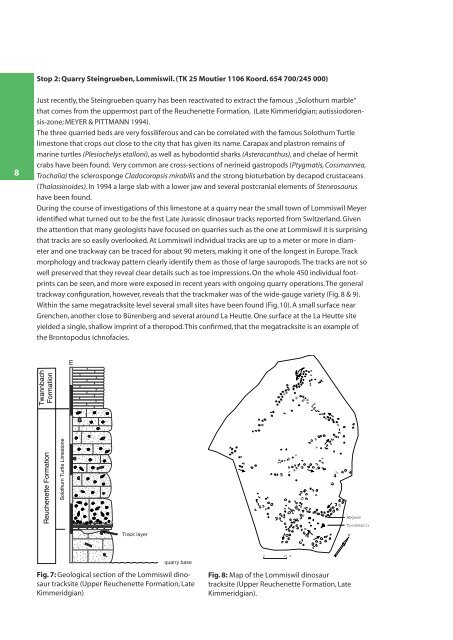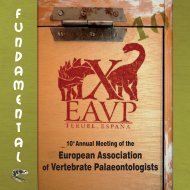1stEAVP MEETING BASEL
1stEAVP MEETING BASEL
1stEAVP MEETING BASEL
- No tags were found...
You also want an ePaper? Increase the reach of your titles
YUMPU automatically turns print PDFs into web optimized ePapers that Google loves.
Stop 2: Quarry Steingrueben, Lommiswil. (TK 25 Moutier 1106 Koord. 654 700/245 000)8Just recently, the Steingrueben quarry has been reactivated to extract the famous „Solothurn marble“that comes from the uppermost part of the Reuchenette Formation, (Late Kimmeridgian; autissiodorensis-zone;MEYER & PITTMANN 1994).The three quarried beds are very fossiliferous and can be correlated with the famous Solothurn Turtlelimestone that crops out close to the city that has given its name. Carapax and plastron remains ofmarine turtles (Plesiochelys etalloni), as well as hybodontid sharks (Asteracanthus), and chelae of hermitcrabs have been found. Very common are cross-sections of nerineid gastropods (Ptygmatis, Cossmannea,Trochalia) the sclerosponge Cladocoropsis mirabilis and the strong bioturbation by decapod crustaceans(Thalassinoides). In 1994 a large slab with a lower jaw and several postcranial elements of Steneosaurushave been found.During the course of investigations of this limestone at a quarry near the small town of Lommiswil Meyeridentified what turned out to be the first Late Jurassic dinosaur tracks reported from Switzerland. Giventhe attention that many geologists have focused on quarries such as the one at Lommiswil it is surprisingthat tracks are so easily overlooked. At Lommiswil individual tracks are up to a meter or more in diameterand one trackway can be traced for about 90 meters, making it one of the longest in Europe. Trackmorphology and trackway pattern clearly identify them as those of large sauropods. The tracks are not sowell preserved that they reveal clear details such as toe impressions. On the whole 450 individual footprintscan be seen, and more were exposed in recent years with ongoing quarry operations. The generaltrackway configuration, however, reveals that the trackmaker was of the wide-gauge variety (Fig. 8 & 9).Within the same megatracksite level several small sites have been found (Fig. 10). A small surface nearGrenchen, another close to Bürenberg and several around La Heutte. One surface at the La Heutte siteyielded a single, shallow imprint of a theropod. This confirmed, that the megatracksite is an example ofthe Brontopodus ichnofacies.TwannbachFormationmReuchenette FormationSolothurn Turtle LimestoneAbgussTrockenrisTrack layerNquarry baseFig. 7: Geological section of the Lommiswil dinosaurtracksite (Upper Reuchenette Formation, LateKimmeridgian)0 10 mFig. 8: Map of the Lommiswil dinosaurtracksite (Upper Reuchenette Formation, LateKimmeridgian).




